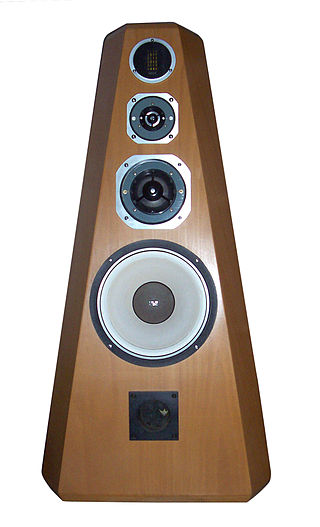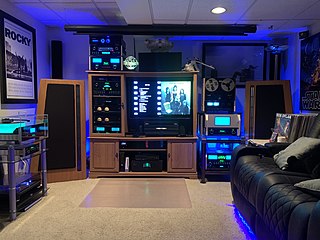
Compactrons are a type of vacuum tube, which contain multiple electrode structures packed into a single enclosure. They were designed to compete with early transistor electronics and were used in televisions, radios, and similar roles.

High fidelity is the high-quality reproduction of sound. It is popular with audiophiles and home audio enthusiasts. Ideally, high-fidelity equipment has inaudible noise and distortion, and a flat frequency response within the human hearing range.

An audio power amplifier amplifies low-power electronic audio signals, such as the signal from a radio receiver or an electric guitar pickup, to a level that is high enough for driving loudspeakers or headphones. Audio power amplifiers are found in all manner of sound systems including sound reinforcement, public address, home audio systems and musical instrument amplifiers like guitar amplifiers. It is the final electronic stage in a typical audio playback chain before the signal is sent to the loudspeakers.

A tuner is a subsystem that receives radio frequency (RF) transmissions, such as FM broadcasting, and converts the selected carrier frequency and its associated bandwidth into a fixed frequency that is suitable for further processing, usually because a lower frequency is used on the output. Broadcast FM/AM transmissions usually feed this intermediate frequency (IF) directly into a demodulator that converts the radio signal into audio-frequency signals that can be fed into an amplifier to drive a loudspeaker.
Avery Robert Fisher was an amateur violinist, a pioneer in the field of high fidelity sound reproduction, founder of the Philharmonic Radio Company and Fisher Electronics, and a philanthropist who donated millions of dollars to arts organizations and universities.

Kenwood is a Japanese brand of consumer electronics. It has been owned by JVCKenwood since October 2011, when Kenwood Corporation merged with JVC. Kenwood manufactures audio equipment such as AM/FM stereo receivers, cassette tape decks/recorders, amateur radio (ham) equipment, radios, cellular phones, speakers, and other consumer electronics.
Lafayette Radio Electronics Corporation was an American radio and electronics manufacturer and retailer from approximately 1931 to 1981, headquartered in Syosset, New York, a Long Island suburb of New York City. The company sold radio sets, Amateur radio (Ham) equipment, citizens band (CB) radios and related communications equipment, electronic components, microphones, public address systems, and tools through their company owned and branded chain of retail outlets and by mail-order.

Sansui Electric Co., Ltd. was a Japanese manufacturer of audio and video equipment. Headquartered in Tokyo, Japan, it was part of the Bermuda conglomerate.
Harman Kardon is a division of US-based Harman International Industries, an independent subsidiary of Samsung Electronics. Harman Kardon was originally founded in Westbury, New York, in 1953 by business partners Sidney Harman and Bernard Kardon.

McIntosh Laboratory is an American manufacturer of handcrafted high-end audio equipment headquartered in Binghamton, New York. It is a subsidiary of McIntosh Group, which is under the ownership umbrella of Highlander Partners, a Dallas-based private equity firm.
Founded by David Hafler and Ed Laurent in Philadelphia, Pennsylvania in 1955, Dynaco was an American hi-fi audio system manufacturer popular in the 1960s and 1970s for its wide range of affordable, yet high quality audio components.. Its best known product was the ST-70 tube stereo amplifier. They also manufactured other tube and solid state amplifiers, preamplifiers, radio tuners and bookshelf loudspeakers. Dynaco was liquidated in 1980, and the trademark is now owned by Radial Engineering Ltd.

A home theater in a box (HTIB) is an integrated home theater package which "bundles" together a combination DVD or Blu-ray player, a multi-channel amplifier, speaker wires, connection cables, a remote control, a set of five or more surround sound speakers and a low-frequency subwoofer cabinet. Manufacturers also have come out with the "soundbar", an all in one device to put underneath the television and that contains all the speakers in one unit.
Armstrong Audio, originally called Armstrong Wireless and Television Ltd. was a British manufacturer of radios and other audio equipment based in London, England. Founded by Claude Charles Jackson in 1932.
H. H. Scott, Inc. was a major manufacturer of hi-fi equipment in the U.S. It was founded in 1947 by Hermon Hosmer Scott in Cambridge, Massachusetts and moved to the nearby town of Maynard in 1957.
Luxman is a brand name of Japanese Luxman Corporation (ラックスマン株式会社) that manufactures luxury audio components. Luxman produces a variety of high-end audio products, including turntables, amplifiers, receivers, tape decks, CD players and speakers.
EICO was a manufacturer of electronics kits located in New York City, New York, United States.
Optonica was a subdivision of Japanese electronics manufacturer Sharp that made high-end hi-fi products and systems.
Technics is a Japanese audio brand established by Panasonic in 1965. Since 1965, Panasonic has produced a variety of hi-fi and audio products under the brand name, such as turntables, amplifiers, radio receivers, tape recorders, CD players, speakers, and digital pianos. Technics products were available for sale in various countries. The brand was originally conceived as a line of high-end audio equipment to compete against brands such as Nakamichi.

Home audio systems refer to audio consumer electronics designed for home entertainment, such as integrated systems like shelf stereos and music centers, as well as individual components like loudspeakers and surround sound receivers. The evolution of home audio began with Edison's phonograph, transitioning from monaural to stereophonic sound in the 1950s and 60s. The term "hi-fi" emerged, highlighting sound accuracy and minimal distortion. Audio equipment evolved from large wooden cabinets to compact units. The 1970s introduced enhancements like quadraphonic sound and technologies like Dolby Pro Logic. The 1970s and 1980s also saw the rise of component-based stereo systems. Cassette decks became a staple in the 1970s. Integrated systems, termed "music centers" gained popularity in the 1980s. Table systems and compact radio receivers emerged as entertainment devices, with some offering features like cassette players and CD functionalities. Audiophile systems prioritize high-quality music formats and specialized equipment like premium turntables, digital-to-analog converters, and other high-end devices, with some enthusiasts preferring the unique sound characteristics of vinyl records and vacuum tubes. Modern systems often emphasize home cinema applications to enhance the audio experience beyond standard TV speakers.

The NAD 3020 is a stereo integrated amplifier by NAD Electronics, considered to be one of the most important components in the history of high fidelity audio. Launched in 1978, this highly affordable product delivered a good quality sound, which acquired a reputation as an audiophile amplifier of exceptional value. By 1998, the NAD 3020 had become the most well known and best-selling audio amplifier in history.


















